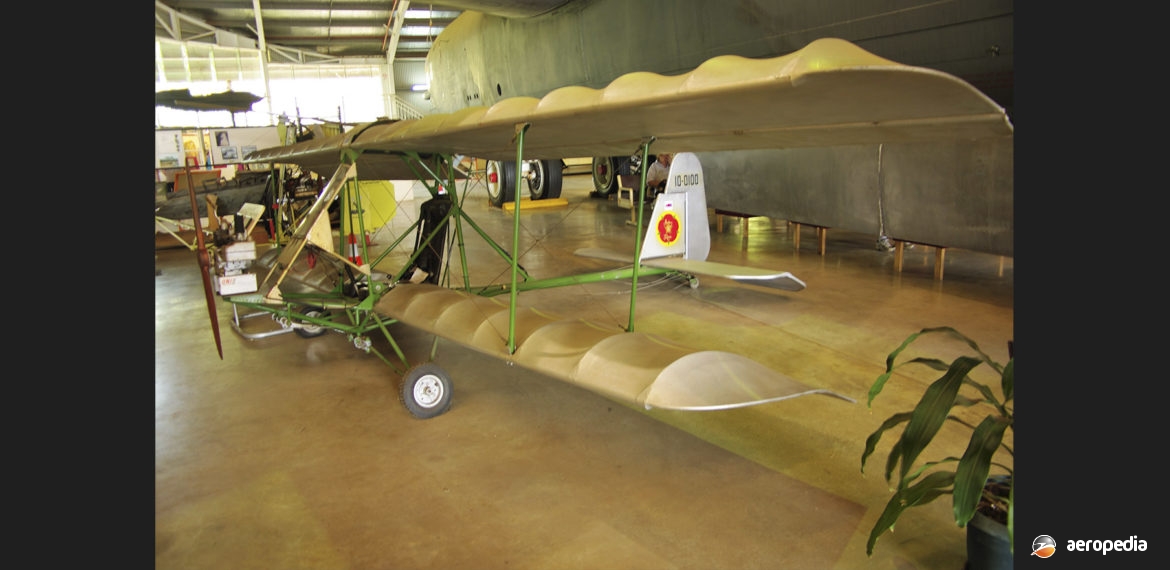Photograph:
Hovey Delta Bird 10-0100 (c/n 477) at the Darwin Aviation Museum, NT in August 2014 (David C Eyre)
Country of origin:
United States of America
Description:
Single-seat ultralight biplane
Power Plant:
One 22 kw (30 hp) at 5,500 rpm Cuyuna 430R two-cylinder, two-stroke, air-cooled engine
Specifications:
- Wingspan [upper]: 7.31 m (24 ft)
- Wingspan [lower]: 6.2 m (20 ft 3 in)
- Length: 4.57 m (15 ft)
- Height: 1.83 m (6 ft)
- Wing area: 14.1 m² (152 sq ft)
- Never exceed speed: 97 km/h (60 mph)
- Max level speed: 97 km/h (60 mph)
- Max cruising speed: 72 km/h (45 mph)
- Stalling speed: 42 km/h (26 mph)
- Max rate of climb at sea level: 122 m/min (400 ft/min)
- Take-off distance: 75 m (250 ft)
- Landing distance: 75 m (250 ft)
- Range at cruising speed: 80 km (50 miles)
- Fuel capacity: 13.2 litres (2.9 Imp gals)
- Empty weight: 99 kg (218 lb)
- Payload weight: 105 kg (232 lb)
- Loaded weight: 204 kg (450 lb)
History:
The Hovey Delta Bird was one of a series of ultralight aircraft designed by Robert Hovey in 1982. It was a single-seat single-engine biplane with conventional three-axis control. Of very simple design, it had an un-swept leading-edge on the wing, constant chord and a conventional tail. The wings were braced by struts and transverse X-cables, the wings having a double surface and being Dacron covered. The undercarriage was a conventional tailwheel type, was bungee suspended and included main wheel brakes and tailwheel steering . Construction was of aluminium tube framework with the pilot sitting in the open, the engine being in front driving a tractor propeller. Like a number of other aircraft of the time, it was designed to comply with US FAR 103 Ultralight Vehicle Regulations which allowed a maximum weight of 115 kg (254 lb).
Power was usually supplied by a Cuyuna 430R engine, this being a conversion of a snowmobile engine for aviation use. The engine was mounted on a triangular framework at the front of the fuselage.
The prototype was first shown to the public at the Experimental Aircraft Association (EAA) event at Oshkosh, Wisconsin in August 1982 and was basically an upgraded and developed Hovey Whing Ding II but with a structure that was simpler to build, with a larger and more powerful engine. It was designed to be an all-terrain aircraft and had conventional controls with ailerons on the trailing-edges of the upper wings.
A few examples have been completed in this region and one, registered 10-0100 (c/n 477) with Recreational Aviation Australia (RAA), after being retired was donated and placed on display at the Darwin Aviation Museum.
Examples have also been registered in New Zealand, these including ZK-FKN (c/n MAANZ/298), registered in January 1985 and withdrawn from use in January 2004, and ZK-FHZ (c/n MAANZ/210), registered in March 1984 and withdrawn from service in November 2001.

